Basic monitoring¶
The free Basic Monitoring service has been set up to alert you to sharp rises or falls in the measured values of the digital offerings. Basic Monitoring is divided into the areas of daily and hourly monitoring ("Monitoring Measured Values Day" and "Monitoring Measured Values Hour") and informs you by e-mail and/or by message in the INFOnline Customer Center if any abnormalities are detected in the course of the measured values.
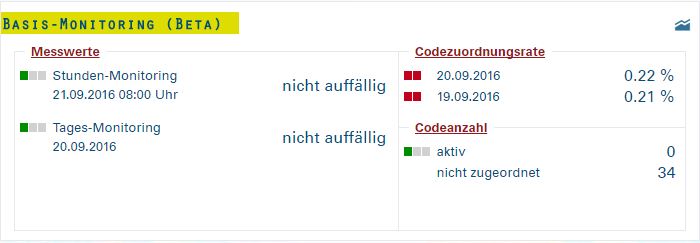
Note
In the case of digital offers with a strongly seasonal usage character or digital offers that are strongly event-related, it is possible that the function of Basis Monitoring will be impaired.
Settings¶
The settings in the Customer Center have been expanded to allow you to customize the notifications (e-mail notification and message in the Customer Center) in Basic Monitoring according to your individual requirements. This ensures that you can use the basic monitoring in the best possible way. The following settings can be made:
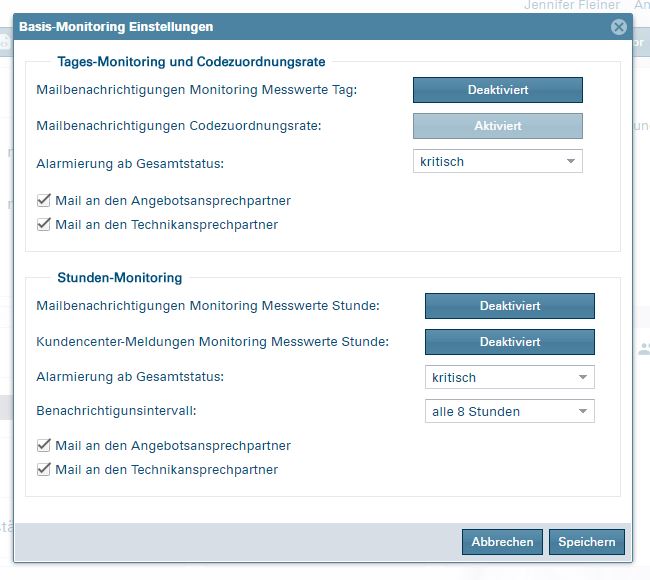
Setting of the alarm levels¶
Here you have the possibility to define from which alarm level (overall status) an alarm should be triggered. The following setting options in relation to the alarming levels are available:
-
Very critical
here only the total status "Very critical" is alarmed. -
Critical
here the total statuses "Critical" and "Very critical" are alarmed. -
Conspicuous
here the total statuses "Conspicuous", "Critical" and "Very critical" are alerted. -
Slightly conspicuous
here the overall statuses "Slightly conspicuous", "Conspicuous", "Critical" and "Very critical" are alerted.
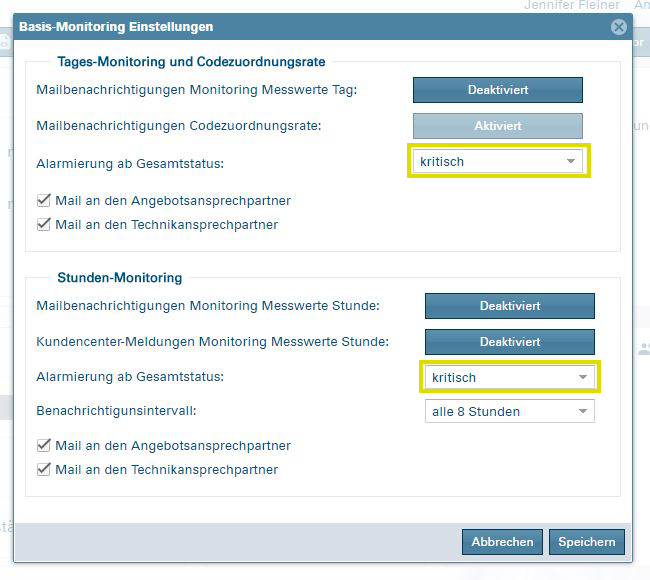
The settings for the alerting levels apply to both the sending of the emails and the display of the messages in the Customer Center itself.
Recipient settings for e-mail notifications¶
According to the initial settings, the e-mail notifications are sent to both the quote contact stored for your digital quote and the technical contact stored.
In the settings of the recipients for the e-mail notifications from the basic monitoring, you have the option to activate or deactivate one or both recipients for the delivery of the messages.
If e-mail notification has been deactivated for one of the stored recipients, this recipient will no longer be notified by e-mail about alerts in basic monitoring in the future.
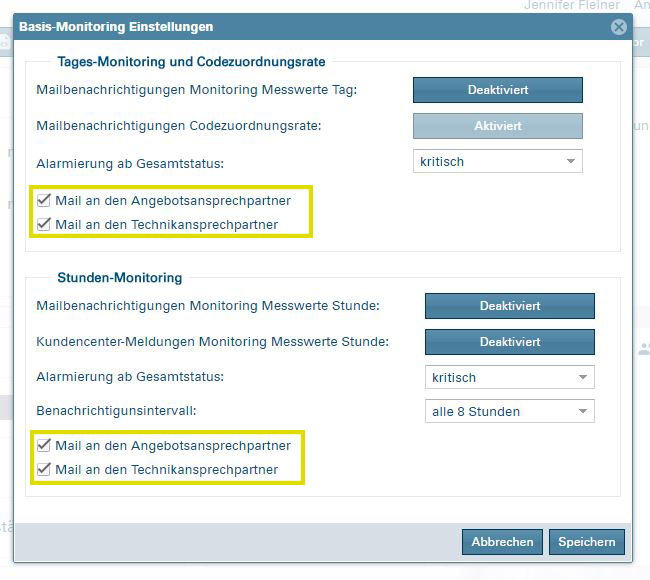
Activation of e-mail notifications¶
E-mail notifications can be activated for daily and hourly monitoring. If, on the other hand, e-mail notifications are deactivated, e-mail notifications for basic monitoring will no longer be delivered.
Activation of the customer center notifications¶
It is also possible to activate the customer center messages for hourly monitoring. If the Customer Center messages have been activated, messages for hour monitoring will be displayed to customers in the INFOnline Customer Center. It is not possible to deactivate the Customer Center messages for daily monitoring.
Message intervals¶
The following setting options are available with regard to the message interval in hourly monitoring:
- Hourly
- Every 4 hours
- Every 8 hours
- Every 12 hours
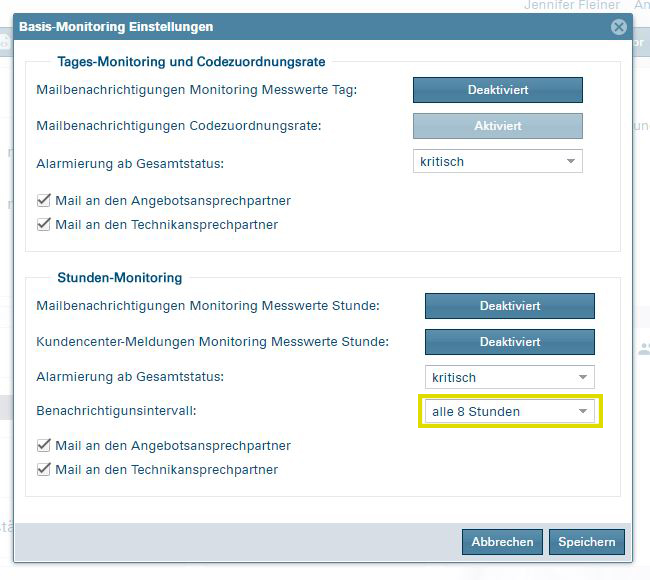
In the daily monitoring an e-mail is sent daily with the reference to the previous day. There is no setting option regarding the interval of the messages here.
Note
The setting of the message interval refers only to the sending of the e-mail notifications in the hour monitoring. The messages in the Customer Center are always sent hourly.
Individual key figures¶
Day monitoring ("Monitoring measured values day")¶
The individual key figures observed in day monitoring are listed in the following table.
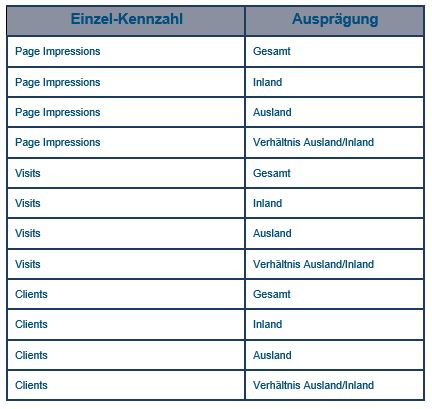
Hourly monitoring ("Monitoring measured values hour")¶
The individual key figures observed in hourly monitoring are listed in the following table.
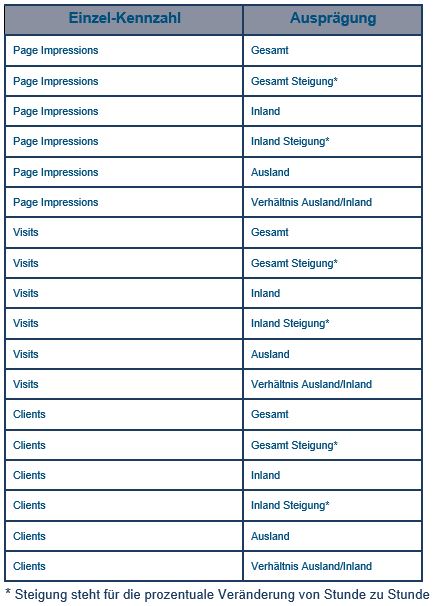
Note
Please note that there may be problems in the history of the hour monitoring for offers that do not have nightly usage in these hours.
Functionality¶
The basic monitoring is divided into the areas of daily and hourly monitoring ("Monitoring measured values day" and "Monitoring measured values hour"). In the daily monitoring 12 different single key figures are considered and in the hourly monitoring 18 different single key figures. Each single key figure is compared with the historical values of the past 10 weeks.
Using an algorithm, a specific status category is calculated for each single KPI based on the comparison with historical values. The status category indicates whether the value of the individual KPI is within the normal range of measured values or whether and to what extent the individual KPI deviates from the expected normal range. The possible status categories of the single KPIs are listed in the following table.
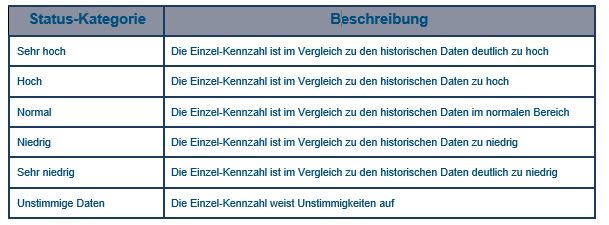
Based on the status categories, the entire data set for the day or hour is assessed in a downstream step. The assessment of the entire data set is done using a linear combination, where each individual key figure is weighted and offset against the status category assigned in the first step. An overall status is then assigned to this data set. When weighting the individual key figures, a slump is weighted more heavily than an increase.
By assigning an overall status per day or hour, it can be seen directly whether there are any anomalies in the measured values or whether the measurement does not show any anomalies. The possible overall statuses are listed in the following table.
Within the scope of the daily monitoring, this calculation of the overall status takes place once a day (publication at approx. 8 a.m. UTC), within the scope of the hourly monitoring, it takes place hourly, whereby a delay of approx. one hour must be taken into account due to the calculation times. The provision of the overall status and the status categories for all individual key figures takes place in the Customer Center.
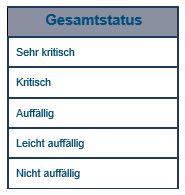
Note
Please note that the hourly and daily monitoring is based on two different data bases. It is therefore possible that the measured values in the hourly monitoring are assessed as inconspicuous over the course of the day, while the entire day is assessed as conspicuous in the daily monitoring.
Most important questions about basic monitoring¶
Is there an overall overview of the key figures?
You can configure your key figures in the basic monitoring (total).
Why is there no data archive?
Currently there is no need. You can get a coverage history of your key figures from the IDAS.
Is data available that is older than 30 days?
No, the data is only available as displayed.
Is it possible to set up a view account for the "Basic Monitoring" module only?
Not for the basic monitoring only. However, you can request a general view account for the Customer Center. This must be done in writing, by e-mail to service@INFOnline.de.
Why can't I turn off the reporting for the code allocation rate?
As IVW customers, the code allocation rate plays a major role in being reported, so it is not possible to deactivate it. Deactivation is possible for INFOnline-only customers.
Can I deactivate the alerts?
As an IVW customer, you can deactivate all alerts except the code assignment rate and active codes in the INFOnline Customer Center. To do this, log in to the INFOnline Customer Center and select the gear wheel at the top right. You can then configure basic monitoring.
Do the alerts affect the IVW reporting?
Depending on the alerting type, it can have an impact on the IVW reporting. If your code allocation rate is below 90% at the end of the month, this may result in non-reporting to IVW.
What happens if I don't take care of the alerts?
Generally, nothing will happen to you. However, it can lead to problems with IVW reporting.
Is there an API so you can download the values?
No, there is no API available to download the data.
I would like to activate the basic monitoring, how do I proceed?
Log in to the INFOnline Customer Center, select the gearwheel at the top right and activate and configure Basic Monitoring entirely according to your needs.
How is the forecast for the digital offering made up?
The calculation of the forecast refers to the last 10 weeks, the same day as well as the weekday group.
Why can't basic monitoring data be provided for the digital offer?
For new customers, it is necessary to have at least 70 days of measurement data in order to calculate a forecast for your digital offer.
Why can't I use basic monitoring?
As long as your digital offering is not registered with IVW, basic monitoring (code allocation rate) is not active.
Who receives the alerts through basic monitoring?
The offer contact as well as technical contact. By default, the alerting is disabled, except for the code assignment rate and active codes.